Supermicro X12SAE W480 Motherboard Review: For Xeon W-1200 Workstations
by Gavin Bonshor on December 11, 2020 9:30 AM ESTCPU Performance, Short Form
For our motherboard reviews, we use our short form testing method. These tests usually focus on if a motherboard is using MultiCore Turbo (the feature used to have maximum turbo on at all times, giving a frequency advantage), or if there are slight gains to be had from tweaking the firmware. We put the memory settings at the CPU manufacturers suggested frequency, making it very easy to see which motherboards have MCT enabled by default.
For Z490/W480 we are running using Windows 10 64-bit with the 1909 update.
Update: A Note About W480 and Turbo
Normally we test our motherboards with out of the box settings. This means that the performance will get boosted based on whatever default algorithm each motherboard vendor implements with regards turbo time and boost power. Intel actively encourages this - the numbers it puts in for turbo time and turbo power are recommendations, rather than specifications, and Intel wants motherboard vendors to engineer their products to the turbo and power that each vendor deems acceptable for their product. As a result, a lot of Z480 motherboards will implement an aggressive turbo algorithm.
W480 motherboards by contrast are more in-line with Intel's recommended settings. Turbo is still there, but it ends up being limited over the short time as determined by Intel. For users that want the 'truer' performance profile of Intel's Comet Lake as defined by the manufacturer, then scoping out a W480 board and W-1200 system might be for you.
Rendering - Blender 2.7b: 3D Creation Suite
A high profile rendering tool, Blender is open-source allowing for massive amounts of configurability, and is used by a number of high-profile animation studios worldwide. The organization recently released a Blender benchmark package, a couple of weeks after we had narrowed our Blender test for our new suite, however their test can take over an hour. For our results, we run one of the sub-tests in that suite through the command line - a standard ‘bmw27’ scene in CPU only mode, and measure the time to complete the render.
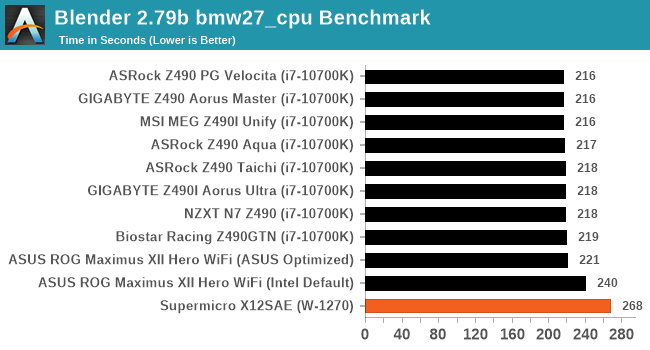
Rendering – POV-Ray 3.7.1: Ray Tracing
The Persistence of Vision Ray Tracer, or POV-Ray, is a freeware package for as the name suggests, ray tracing. It is a pure renderer, rather than modeling software, but the latest beta version contains a handy benchmark for stressing all processing threads on a platform. We have been using this test in motherboard reviews to test memory stability at various CPU speeds to good effect – if it passes the test, the IMC in the CPU is stable for a given CPU speed. As a CPU test, it runs for approximately 1-2 minutes on high-end platforms.
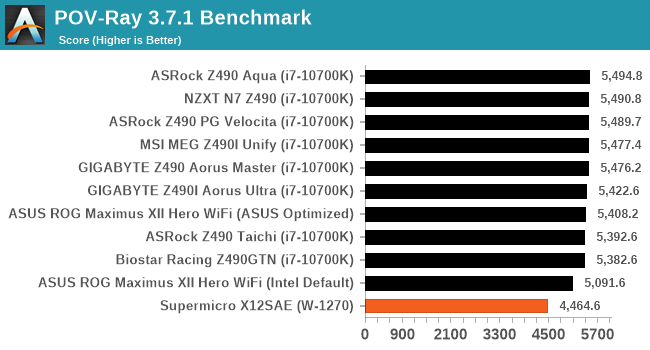
Rendering - Crysis CPU Render
One of the most oft used memes in computer gaming is ‘Can It Run Crysis?’. The original 2007 game, built in the Crytek engine by Crytek, was heralded as a computationally complex title for the hardware at the time and several years after, suggesting that a user needed graphics hardware from the future in order to run it. Fast forward over a decade, and the game runs fairly easily on modern GPUs, but we can also apply the same concept to pure CPU rendering – can the CPU render Crysis? Since 64 core processors entered the market, one can dream. We built a benchmark to see whether the hardware can.
For this test, we’re running Crysis’ own GPU benchmark, but in CPU render mode. This is a 2000 frame test, which we run over a series of resolutions from 800x600 up to 1920x1080. For simplicity, we provide the 1080p test here.
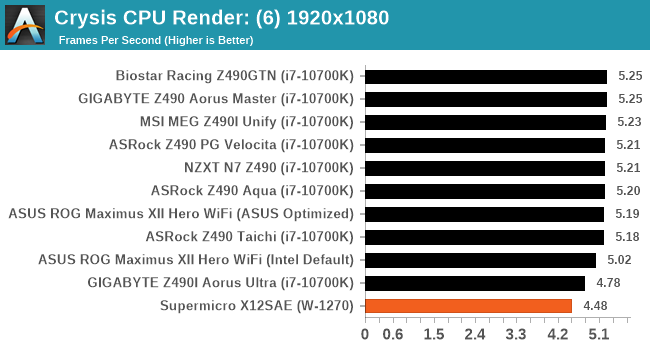
Point Calculations – 3D Movement Algorithm Test: link
3DPM is a self-penned benchmark, taking basic 3D movement algorithms used in Brownian Motion simulations and testing them for speed. High floating point performance, MHz, and IPC win in the single thread version, whereas the multithread version has to handle the threads and loves more cores. For a brief explanation of the platform agnostic coding behind this benchmark, see my forum post here.
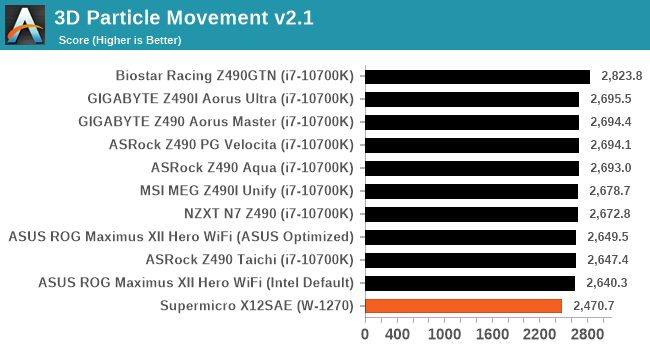
NAMD ApoA1
One frequent request over the years has been for some form of molecular dynamics simulation. Molecular dynamics forms the basis of a lot of computational biology and chemistry when modeling specific molecules, enabling researchers to find low energy configurations or potential active binding sites, especially when looking at larger proteins. We’re using the NAMD software here, or Nanoscale Molecular Dynamics, often cited for its parallel efficiency. Unfortunately the version we’re using is limited to 64 threads on Windows, but we can still use it to analyze our processors. We’re simulating the ApoA1 protein for 10 minutes, and reporting back the ‘nanoseconds per day’ that our processor can simulate. Molecular dynamics is so complex that yes, you can spend a day simply calculating a nanosecond of molecular movement.
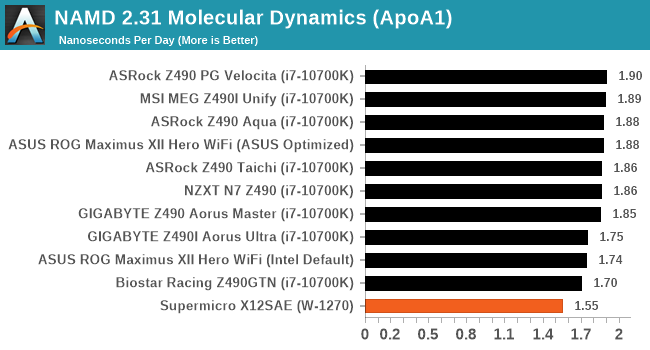


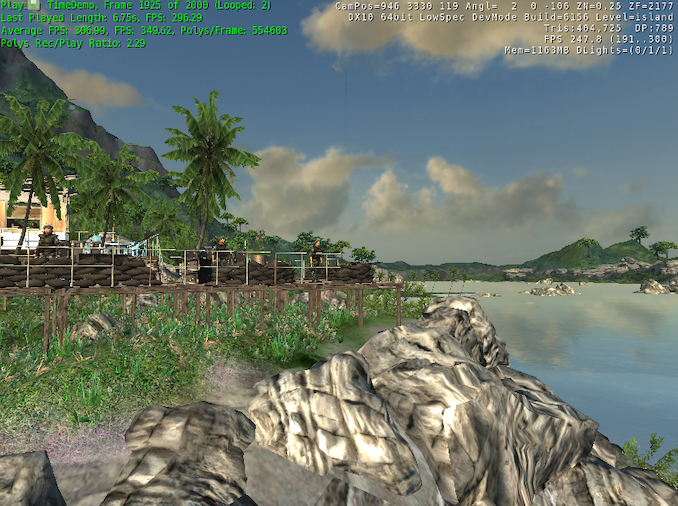








55 Comments
View All Comments
MFC - Friday, December 11, 2020 - link
Check the 2nd line in the Monolithic Power Systems Mosfet. The top line is the date code, the 2nd line is the part number. 3rd line is the lot number.tpurves - Friday, December 11, 2020 - link
I... don't understand how AMD does not seem to exist in the universe where you are testing this board? Hasn't AMD pretty much made any Intel-based workstation/HEDT build pointless at this point? or what am I missing here that you would want to consider building a Xeon workstation for in 2021? I can't tell because the word 'AMD' is not even mentioned in the entire review.DannyH246 - Friday, December 11, 2020 - link
Classic behaviour from www.IntelTech.com.No review of the new AMD GPU's to be seen. And no mention of AMD in this review. (i.e how this board is effectively a waste of money, as who would want to by Intel at the moment)
Operandi - Friday, December 11, 2020 - link
Point being why even review this in the context of a world where the platform AMD exists? From a feature and performance stance AMD is better on both. Unless there is something Supermicro has that other board vendors don't as I don't think Supermicro has a "workstation" AM4 board but still, so what...christinescoms - Saturday, December 12, 2020 - link
hellochristinescoms - Saturday, December 12, 2020 - link
I get paid more than 120 to 130 per hour for working online. I heard about this job 3 months ago and after joining this i have earned easily 15k from this without having online working skills. This is what I do.....___christinescoms - Saturday, December 12, 2020 - link
I get paid more than 120 to 130 per hour for working online. I heard about this job 3 months ago and after joining this i have earned easily 15k from this without having online working skills. This is what I do.....___christinescoms - Saturday, December 12, 2020 - link
I get paid more than 120 to 130 per hour for working online. I heard about this job 3 months ago and after joining this i have earned easily 15k from this without having online working skills. This is what I do.....___bit.ly/googlework75Deicidium369 - Friday, December 11, 2020 - link
Yeah how shortsighted to not include AMD in a review of an Intel motherboard - this is pure fanboyism on Anandtech's part.../s
Oxford Guy - Friday, December 11, 2020 - link
People are quick to claim maliciousness but sometimes oversights and oversights.It is an oversight to not present a product in its context. The context does include the competition.